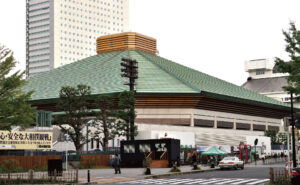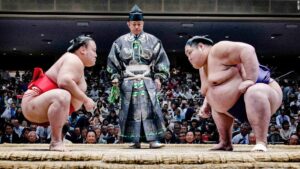 Sumo wrestling (相撲) is Japan’s national sport — a fascinating blend of athletic power, ancient Shinto ritual, and cultural tradition. Watching a live sumo tournament is one of the most unforgettable experiences travelers can have in Japan.
Sumo wrestling (相撲) is Japan’s national sport — a fascinating blend of athletic power, ancient Shinto ritual, and cultural tradition. Watching a live sumo tournament is one of the most unforgettable experiences travelers can have in Japan.
Here’s a detailed guide to help you understand the rules, atmosphere, and practical tips for enjoying sumo to the fullest.
Contents
- 1 What Is Sumo?
- 2
- 3 When and Where to See Sumo
- 4 How to Get Tickets
- 5 Tournament Schedule and Best Time to Go
- 6 What You’ll See
- 7 Sumo Etiquette for Visitors
- 8 What to Eat: The Wrestler’s Meal — Chanko Nabe
- 9 Visiting a Sumo Stable
- 10 Cultural Meaning of Sumo
- 11 Practical Information
- 12 Why You Should Experience Sumo
What Is Sumo?
Sumo is Japan’s oldest organized sport, with roots dating back over 1,500 years. Originally performed as a Shinto ritual to entertain the gods and pray for good harvests, it evolved into the professional sport seen today.
Two wrestlers, called rikishi, face each other in a circular ring (called a dohyō), aiming to force the opponent out of the ring or make any part of their body (except the soles of their feet) touch the ground.
Despite its simplicity, sumo is rich in tradition and ceremony, making it both a sport and a living cultural performance.
When and Where to See Sumo
There are six official Grand Sumo Tournaments (Honbasho) each year, held in different cities across Japan:
| Month | City | Venue |
|---|---|---|
| January | Tokyo | Ryōgoku Kokugikan |
| March | Osaka | EDION Arena |
| May | Tokyo | Ryōgoku Kokugikan |
| July | Nagoya | Dolphins Arena |
| September | Tokyo | Ryōgoku Kokugikan |
| November | Fukuoka | Fukuoka Kokusai Center |
Each tournament lasts 15 days, and matches take place every day during that period.
If your trip doesn’t coincide with a tournament, you can still watch sumo morning practice (asageiko) at sumo stables (heya) in Tokyo — where wrestlers live and train.
How to Get Tickets
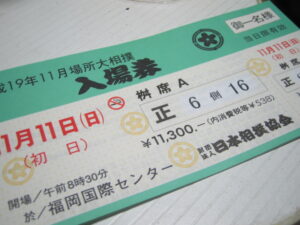
Sumo is popular, so it’s best to book early. Tickets are sold by the Japan Sumo Association (Nihon Sumō Kyōkai), convenience stores, and official partners.
Types of seats:
-
Box Seats (Masu-seki): Traditional tatami areas for up to 4 people. You sit on cushions on the floor — the most authentic way to watch, but also more expensive.
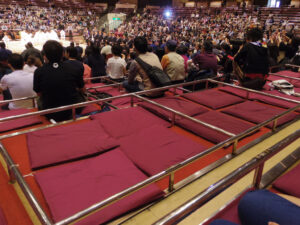
-
Chair Seats (Arena): Regular Western-style seats, comfortable for most visitors.
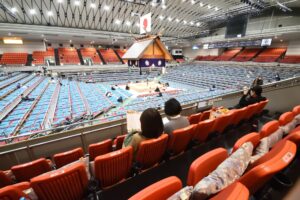
-
Upper-Level Seats: Cheaper, good for casual fans or last-minute travelers.
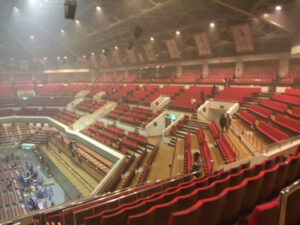
Prices range from around ¥4,000 (upper seats) to ¥20,000+ (ringside seats) depending on location and tournament.
Where to buy:
-
Ticket booths at the venue (limited availability)
Tournament Schedule and Best Time to Go
Matches start in the morning with the lower-ranked wrestlers, gradually building up to the top division (Makuuchi) in the late afternoon.
If you only have a few hours, the best time to arrive is around 2:30–3:00 p.m., when the top wrestlers’ bouts begin.
Each match lasts only a few seconds, but the ceremonies, rituals, and tension before each bout make it thrilling to watch.
What You’ll See
A sumo match is not just about wrestling — it’s a spiritual performance steeped in symbolism.
-
Dohyō (Ring): Made of clay and covered with sand; it’s considered sacred.
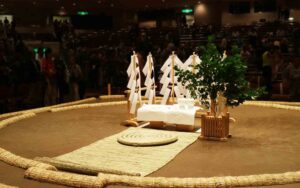
-
Ritual Salt Throwing: Wrestlers throw salt to purify the ring and protect themselves from injury.
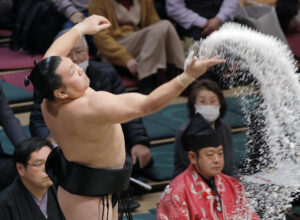
-
Shikiri (Standoff): The psychological battle — wrestlers stare at each other, stomp their feet, and slap their bodies before charging.
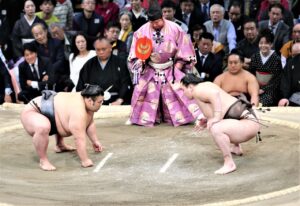
-
Gyōji (Referee): Wears ornate robes inspired by samurai court attire.
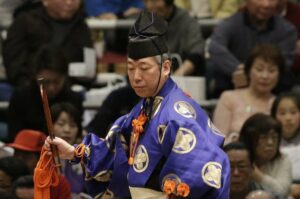
-
Yokozuna (Grand Champion): Performs a special ring-entering ceremony (dohyō-iri) wearing a thick braided belt called a tsuna, symbolizing the highest honor in sumo.
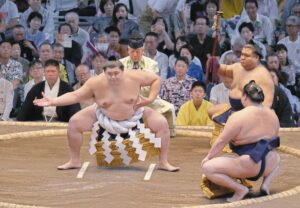
Sumo Etiquette for Visitors
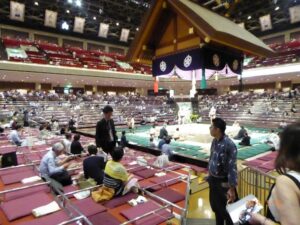
To fully enjoy the experience and show respect for tradition, keep these tips in mind:
-
Arrive quietly and on time. Matches run all day, so you can enter anytime — but avoid walking around during bouts.
-
No cheering aggressively. Applause and quiet excitement are welcome; avoid shouting or standing.
-
Shoes off in box seats. You’ll sit on cushions, often barefoot or in socks.
-
Photography: Allowed in most areas, but turn off flash — never during a match’s final moments.
-
Food and Drink: You can eat in your seat! Try bento boxes or chanko nabe (the wrestlers’ traditional stew).
-
Respect the wrestlers. They are professionals and cultural icons — do not approach them for selfies during tournaments.
What to Eat: The Wrestler’s Meal — Chanko Nabe
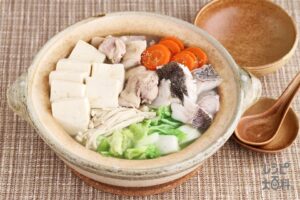
Many sumo stables and nearby restaurants serve Chanko Nabe (ちゃんこ鍋) — a hearty hot pot filled with meat, fish, tofu, and vegetables. It’s the same meal wrestlers eat daily to build strength.
Some famous spots near Ryōgoku Kokugikan in Tokyo include:
-
Chanko Tomoegata
-
Chanko Kawasaki
-
Chanko Kiri
Eating chanko before or after watching sumo makes the experience even more authentic.
Visiting a Sumo Stable
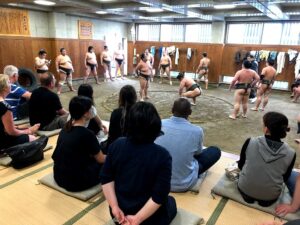
Outside tournament seasons, you can visit a sumo training stable (beya) in Tokyo to watch morning practice.
Visitors must stay quiet and sit respectfully on the tatami floor as wrestlers train in intense sessions.
Tips:
-
Make reservations through official channels or tour operators.
-
Dress modestly and avoid distracting behavior.
-
Never step onto the practice ring.
These visits offer a rare, behind-the-scenes glimpse into the discipline and lifestyle of professional wrestlers.
Cultural Meaning of Sumo
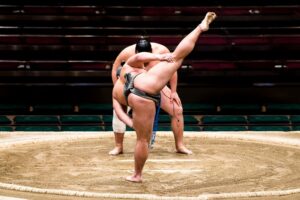
Sumo embodies the Japanese spirit of respect, purity, and perseverance. Every gesture, from the salt toss to the deep bow after a match, carries cultural meaning.
Even for visitors who don’t understand the rules perfectly, the combination of strength, ritual, and atmosphere leaves a lasting impression.
Practical Information
-
Typical Tournament Hours: 8:30 a.m. – 6:00 p.m.
-
Duration: Each match lasts seconds; top division starts around 3 p.m.
-
Dress Code: Casual, but modest (especially if sitting close to the ring).
-
Souvenirs: Official shops sell sumo-themed goods, towels, sweets, and ranking charts (banzuke).
Why You Should Experience Sumo
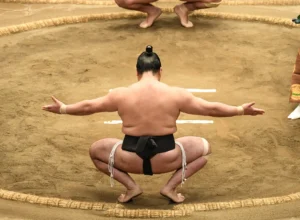
Watching sumo isn’t just a sports event — it’s witnessing a living Japanese tradition that has survived for centuries. From the rhythmic drumbeats that open the day to the dramatic final bout, every moment is charged with culture and emotion.
Whether you’re a sports fan, a culture lover, or simply curious, a day at the sumo will give you an unforgettable glimpse into the soul of Japan.
Official Website
https://www.sumo.or.jp/En/
Accommodation sites
Agoda
